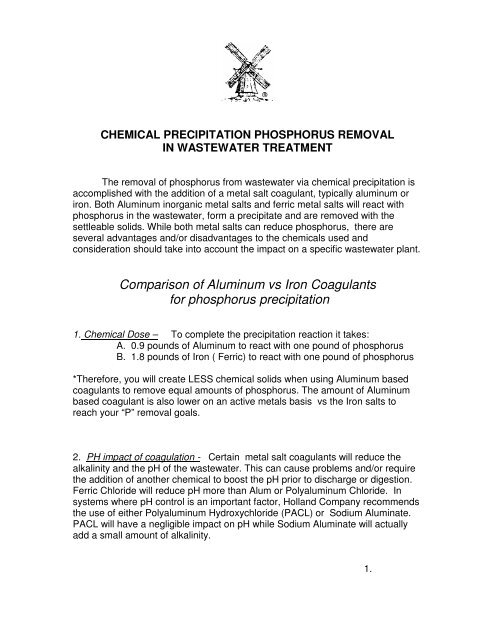Comparison of Aluminum vs Iron Coagulants for phosphorus ...
Comparison of Aluminum vs Iron Coagulants for phosphorus ...
Comparison of Aluminum vs Iron Coagulants for phosphorus ...
Create successful ePaper yourself
Turn your PDF publications into a flip-book with our unique Google optimized e-Paper software.
CHEMICAL PRECIPITATION PHOSPHORUS REMOVAL<br />
IN WASTEWATER TREATMENT<br />
The removal <strong>of</strong> <strong>phosphorus</strong> from wastewater via chemical precipitation is<br />
accomplished with the addition <strong>of</strong> a metal salt coagulant, typically aluminum or<br />
iron. Both <strong>Aluminum</strong> inorganic metal salts and ferric metal salts will react with<br />
<strong>phosphorus</strong> in the wastewater, <strong>for</strong>m a precipitate and are removed with the<br />
settleable solids. While both metal salts can reduce <strong>phosphorus</strong>, there are<br />
several advantages and/or disadvantages to the chemicals used and<br />
consideration should take into account the impact on a specific wastewater plant.<br />
<strong>Comparison</strong> <strong>of</strong> <strong>Aluminum</strong> <strong>vs</strong> <strong>Iron</strong> <strong>Coagulants</strong><br />
<strong>for</strong> <strong>phosphorus</strong> precipitation<br />
1. Chemical Dose – To complete the precipitation reaction it takes:<br />
A. 0.9 pounds <strong>of</strong> <strong>Aluminum</strong> to react with one pound <strong>of</strong> <strong>phosphorus</strong><br />
B. 1.8 pounds <strong>of</strong> <strong>Iron</strong> ( Ferric) to react with one pound <strong>of</strong> <strong>phosphorus</strong><br />
*There<strong>for</strong>e, you will create LESS chemical solids when using <strong>Aluminum</strong> based<br />
coagulants to remove equal amounts <strong>of</strong> <strong>phosphorus</strong>. The amount <strong>of</strong> <strong>Aluminum</strong><br />
based coagulant is also lower on an active metals basis <strong>vs</strong> the <strong>Iron</strong> salts to<br />
reach your “P” removal goals.<br />
2. PH impact <strong>of</strong> coagulation - Certain metal salt coagulants will reduce the<br />
alkalinity and the pH <strong>of</strong> the wastewater. This can cause problems and/or require<br />
the addition <strong>of</strong> another chemical to boost the pH prior to discharge or digestion.<br />
Ferric Chloride will reduce pH more than Alum or Polyaluminum Chloride. In<br />
systems where pH control is an important factor, Holland Company recommends<br />
the use <strong>of</strong> either Polyaluminum Hydroxychloride (PACL) or Sodium Aluminate.<br />
PACL will have a negligible impact on pH while Sodium Aluminate will actually<br />
add a small amount <strong>of</strong> alkalinity.<br />
1.
3. Obtaining Very Low Levels <strong>of</strong> Phosphorus - Studies have proven that the use<br />
<strong>of</strong> <strong>Aluminum</strong> based coagulants will achieve lower levels <strong>of</strong> <strong>phosphorus</strong> <strong>vs</strong> <strong>Iron</strong><br />
salts. This is an important consideration as new lower limits (0.2 mg/l or less) are<br />
being required<br />
4. UV Disinfection Impact - The addition <strong>of</strong> ferric chloride or ferric sulfate as the<br />
coagulant has a negative effect on the UV system. The ferric ion interferes with<br />
the UV wavelength and can “Coat” the UV light crystal, causing increased power<br />
consumption to overcome the reduced efficiency. This is Not a problem with<br />
aluminum based coagulants.<br />
5. Clarifier Per<strong>for</strong>mance enhancement - The addition <strong>of</strong> Alum or Polyaluminum<br />
Chloride has the secondary benefit <strong>of</strong> enhanced clarifier settling efficiency. Lower<br />
turbidity and TSS will help plants meet permit limits, improve the quality <strong>of</strong> the<br />
effluent and most importantly, capture the insoluble <strong>phosphorus</strong> containing solids<br />
that might otherwise escape the clarifier and enter the plant effluent<br />
6. Chemical Handling / Safety - Alum and Polyaluminum Chloride (PACL) are<br />
easier to handle and store <strong>vs</strong> Ferric Chloride. The ferric is very corrosive,<br />
requires special pumps and feed equipment and will “Stain” plant systems and<br />
equipment an orange/brown color.<br />
7. Re-release <strong>of</strong> chemically bound <strong>phosphorus</strong> - Under anoxic conditions, <strong>Iron</strong><br />
phosphate compounds are more likely to release the bound <strong>phosphorus</strong> back<br />
into the system or even release the <strong>phosphorus</strong> from residuals that were land<br />
applied, causing downstream higher <strong>phosphorus</strong> levels. <strong>Aluminum</strong> phosphate<br />
precipitates are more strongly bound and there<strong>for</strong>e will not re-release.<br />
8. Additional Heavy Metal Impurities - Certain grades <strong>of</strong> ferric chloride, ferric<br />
sulfate and ferrous sulfates contain higher levels <strong>of</strong> heavy metal impurities. This<br />
needs to be reviewed prior to using the lower cost impure grades <strong>of</strong> ferric<br />
For more in<strong>for</strong>mation<br />
Holland Company, Inc.<br />
800-639-9602<br />
www.hollandcompany.com
Typical Chemical Treatment Feed Options<br />
1. Chemical treatment to the raw/primary influent wastewater<br />
2. Dual feed to influent/ effluent <strong>of</strong> biological plants<br />
3. Post secondary treatment be<strong>for</strong>e polishing filters<br />
Tertiary filters


